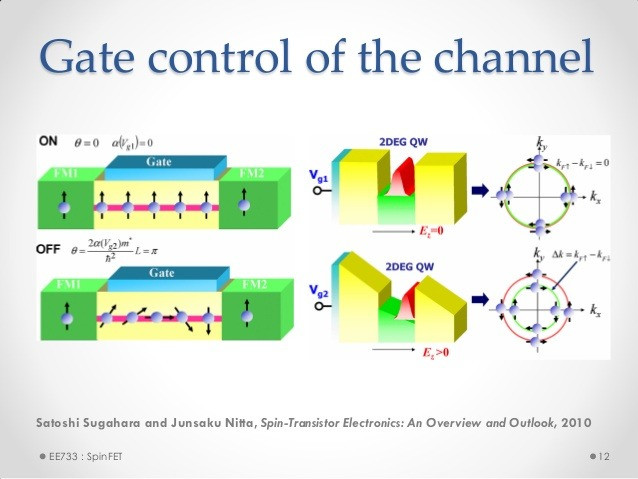SpinFETs – The Transistor of the Future
| 19-04-2021 | By Robin Mitchell
Researchers are always looking at new methods to improve technology, and SpinFETs could be a potential solution. What is spintronics, what are SpinFETs, and why could they be the key to future electronics?
What is Spintronics?
Spintronics is the field of electronics that utilises the transportation of electron spin in solid-state materials. Simply put, traditional electronics utilise current flow (i.e. charge) to perform actions while spintronics utilises the flow of electron spin.
Electrons have many different properties including mass and charge, but one of these properties is called spin. An observed electron will have one of two spin states; up or down. Unless an electron in a quantum state (where the spin is expressed as a probability between the two states), the electron can only have a single spin state.
While spintronics is incredibly advanced and involved, the basic operation behind spintronics is relatively simple to understand. Spintronics utilises ferromagnetic materials as ferromagnet materials mostly get their magnetic properties from the spin of electrons. Specifically, electrons in a ferromagnetic material will all have the same spin state and direction.
Arguably, the most important effect of ferromagnet materials is that injected electrons into said material face less resistance if the injected electrons have the same spin.
What is a SpinFET?
A SpinFET is a transistor technology that controls a current flow using the spin of electrons instead of a charged layer. Many research papers and lectures seem to overcomplicate the function of such transistors with long quantum equations, but the action of a SpinFET is simpler than one would think.
A SpinFET has a source, drain, and gate like a standard transistor. However, the source and drain are made from a ferromagnet material, while the channel between the two is a standard semiconductor material such as silicon.
The source, drain and channel have their spin fixed to the same orientation. The gate, just like a standard FET, is placed above the channel. If there is no voltage present on the gate, electrons can move from the source, through the channel, and into the drain.
If, however, a voltage is applied to the gate, the electrons in the channel orient themselves, which causes their spin to change. While electrons can happily move off the source and into the channel, the electrons that try to get into the drain have a different spin polarisation than that of the drain. As such, electrons struggle to get into the drain, and therefore the transistor is switched off (i.e. no current flow).

Image courtesy SlideShare
Why are SpinFETs considered to be the next generation transistor?
While spintronics is still in its infancy (as there are no SpinFET devices in commercialisation yet), their inherent properties make them ideal for replacing standard silicon transistors. The first benefit of spintronics is that it makes use of electron spin instead of charge flow. This is a critical property as electron spin can be modulated much faster than creating a conductive channel.
Some researchers also believe that electron spin will allow the creation of circuits tuned to spin detection, which would remove the need for noisy amplifiers that utilise current flow, thereby making much more sensitive electronics.
Another bonus to using spintronics, in general, is that ferromagnet materials retain their spin orientation even when power is removed. This has led to many researchers rushing to create a new type of RAM called Magnetic RAM, or MRAM for short. This RAM has infinite read/write cycles and has fast access times that could provide computers with the first unified memory where programs, files, and cache are stored in one memory location.
Read More

